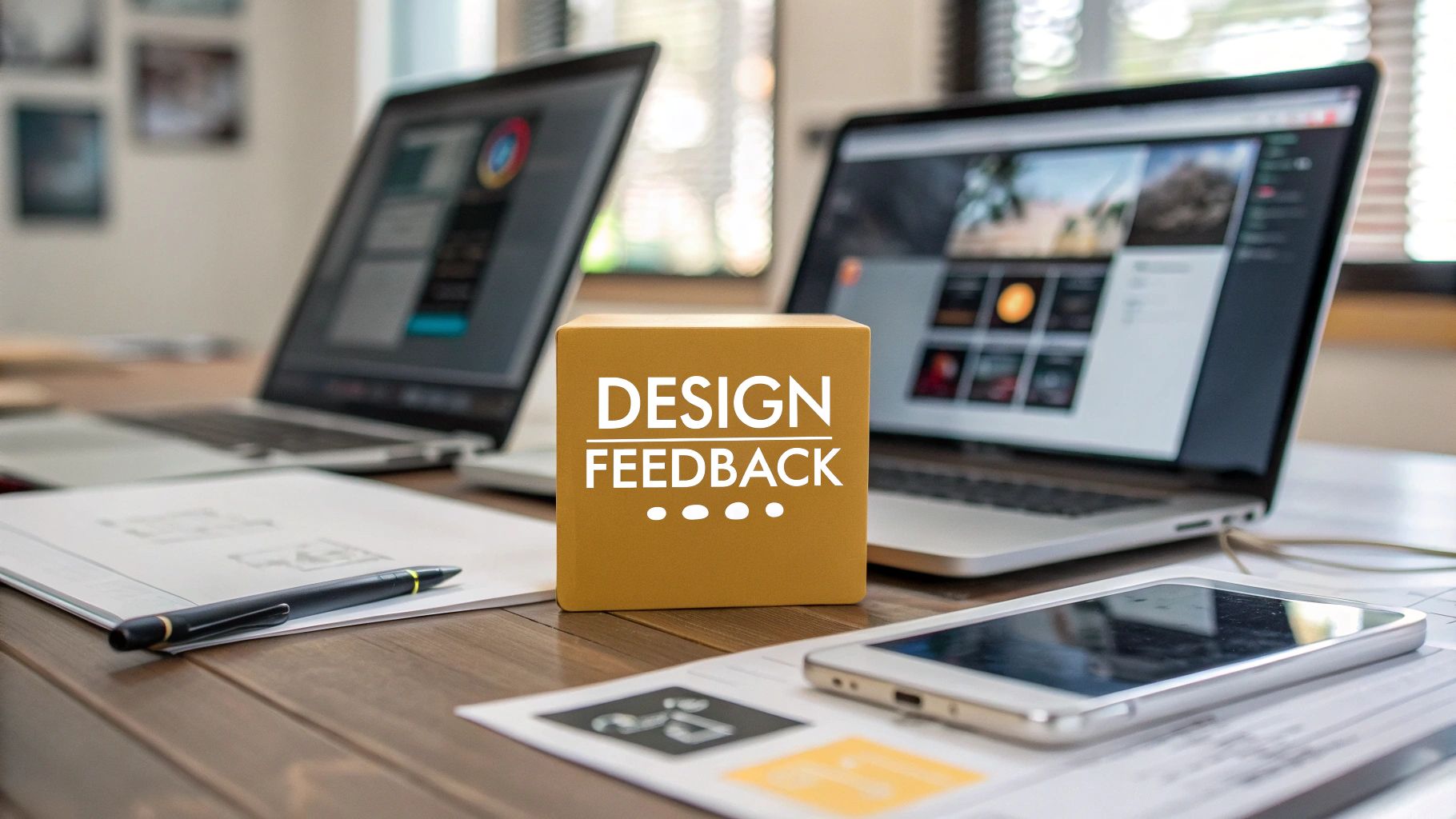Why Feedback on Website Design Transforms Results

First impressions are everything online. Your website's design is often the first thing a visitor sees, setting the stage for their entire experience. That's why getting feedback on your website design isn't just a good practice – it's essential for online success. Understanding how users perceive your design directly impacts your bottom line.
The Impact of First Impressions
Website design is paramount, especially regarding user feedback. A staggering 94% of first impressions are design-related, highlighting design's critical role in user engagement. What's more, 88% of online consumers are less likely to return after a bad experience. For example, confusing navigation or slow loading times can quickly turn potential customers away. This emphasizes the constant need for improvement based on user input. Learn more compelling statistics on website design at Linearity.
Feedback Fuels Growth
Websites actively seeking and implementing design feedback hold a significant edge. Think of your website as a garden: without regular care and adjustments, it won't flourish. Websites, like gardens, must adapt based on user input for sustainable growth. This creates a cycle of continuous improvement, boosting engagement, conversions, and profits.
Real-World Transformations
Many brands have seen incredible results through systematic feedback. By analyzing user feedback and making targeted design changes, companies have achieved remarkable improvements:
-
Reduce Bounce Rates: A clearer call to action, informed by feedback, can significantly lower bounce rates and encourage deeper exploration.
-
Increase Engagement: Improved site navigation, based on user feedback, leads to longer site visits and more content interaction.
-
Boost Conversions: Streamlined checkout processes, often a direct result of user feedback, simplify purchasing and boost conversion rates.
The Psychology of Design Feedback
The true power of design feedback lies in understanding user psychology. Visitors react to design, both consciously and subconsciously. Feedback provides a window into these reactions, allowing you to:
-
Identify Pain Points: Discover user frustrations and address them head-on.
-
Uncover Hidden Opportunities: Find areas where design enhancements can elevate the user experience.
-
Build Trust and Credibility: A well-designed website, shaped by user feedback, fosters trust and positions your brand as an industry leader.
By consistently gathering and acting on website design feedback, you can transform your online presence. Create a more engaging and profitable experience for both your business and your users. This proactive approach is crucial for staying competitive and achieving online success.
Design Elements That Make or Break User Experience

A website's design does more than just make it look appealing. It has a powerful impact on how users perceive your brand and interact with your content. Certain design elements, often registered subconsciously, can instantly build trust or raise red flags. Understanding these elements is key to gathering valuable feedback and refining your site for maximum impact.
Let's explore how specific design choices influence user perception and drive engagement. Crafting a user-centered design is about more than just aesthetics; it's about creating a seamless and enjoyable experience that encourages users to explore, interact, and ultimately, convert.
The Hierarchy of Visual Perception
Users don't process every design element with equal weight. Just as we scan a new environment when we enter it, our eyes prioritize certain aspects of a website. Understanding this natural hierarchy lets you focus your design efforts where they'll have the most significant impact.
-
Navigation: Intuitive navigation is crucial. Users should instantly grasp how to find what they need. A confusing menu structure is like a poorly designed roadmap, leading to frustration and abandonment.
-
Typography: Font choices greatly influence readability and brand perception. A website with cluttered or illegible fonts loses credibility. Imagine a serious financial institution using a playful, whimsical font – the mismatch undermines their authority.
-
Color Palette: Colors evoke emotions and shape user behavior. A well-chosen color palette creates a sense of calm and professionalism, while clashing colors can distract and even repel users.
-
Imagery and Graphics: Visuals can enhance storytelling and user engagement. However, irrelevant or unoptimized images can slow down loading times and clutter the user experience. Every visual element should serve a purpose and contribute to a cohesive whole.
To illustrate the varying impact these elements have, let's examine the following table:
To understand how these elements impact user perception, let's consider the following table:
Design Elements Impact on User Perception
| Design Element | Initial Impact | Long-Term Engagement | Feedback Frequency |
|---|---|---|---|
| Navigation | Strong – determines ease of use | High – impacts overall satisfaction | Very High – users quickly complain about navigation issues |
| Typography | Moderate – influences readability and brand perception | Medium – affects content consumption | Medium – feedback often relates to readability |
| Color Palette | Moderate – sets the emotional tone | Medium – contributes to overall feel | Low – unless jarring, users rarely comment directly on color |
| Imagery & Graphics | Strong – grabs attention | Low – unless directly related to content | Medium – feedback tends to focus on relevance and quality |
This table highlights how seemingly small design choices can have a significant impact on user experience. By understanding these elements and their respective influence, you can prioritize design improvements effectively.
Prioritizing Design Improvements Based on User Feedback
Once you understand the hierarchy of visual perception, you can strategically prioritize design improvements. Focusing feedback efforts on navigation and typography often yields the greatest gains in user experience. These foundational elements shape the entire user journey and directly impact their ability to find information and engage with your content.
The Psychology of Design Feedback
Analyzing user feedback unveils important psychological patterns. For instance, users consistently prioritize clarity and simplicity. Clear calls to action, concise content, and uncluttered layouts usually garner positive feedback. Conversely, elements that obstruct quick access to information, like intrusive pop-ups or excessive animations, often generate negative responses.
Feedback often reveals that visual appeal and usability are paramount. A study by Adobe found that 59% of consumers prefer beautifully designed websites over simple ones, and 54% value websites that resonate with their design sensibilities. These statistics underscore the importance of aesthetics in crafting a positive user experience. Find more statistics on website design at My Codeless Website.
Balancing Aesthetics and Functionality
While aesthetics are essential, they shouldn't compromise functionality. A visually stunning website that's difficult to navigate will ultimately fail to achieve its goals. Striking the right balance between aesthetics and functionality is crucial, and it's often a key focus area when gathering feedback.
From Feedback to Action: Addressing User Concerns
User feedback provides a clear roadmap for design improvements. Addressing specific concerns, like navigation difficulties or slow loading times, allows you to iteratively enhance your website. Tools like BugSmash can be invaluable for collecting and managing this feedback effectively. By streamlining this process, BugSmash empowers you to turn raw feedback into actionable design decisions, ultimately creating a website that not only looks great but also performs exceptionally well.
Gathering Feedback That Actually Drives Improvements

Generic surveys rarely provide the specific insights needed for real website improvement. This section explores more effective methods for gathering website design feedback, feedback that can lead to significant enhancements. We’ll examine different approaches, comparing their costs, data quality, and actionable insights.
Beyond Basic Surveys: Advanced Feedback Collection Methods
Want feedback that’s more than just vague opinions? Consider these advanced methods:
-
Moderated User Testing: Observing users interacting with your website in real-time, guided by a moderator, offers rich qualitative data. You see firsthand where users struggle and gain valuable insights into their thought processes. This method, however, requires more resources than others.
-
Heatmaps and Session Recordings: Tools like Hotjar provide visual representations of user behavior, highlighting clicks, scrolls, and areas where users linger. This data unveils unexpected patterns and pinpoints areas for improvement. Imagine discovering users consistently overlook a critical call to action – heatmaps can reveal just that.
-
Contextual Interviews: Speaking with users while they’re actively using your website, or immediately after a specific task, delivers invaluable insights. This method provides context often missed by traditional surveys, uncovering motivations and frustrations.
-
A/B Testing: Optimizely is a platform allowing you to compare different design versions, revealing which performs better. By tracking interactions, you gather data on which design leads to higher conversion rates and improved engagement.
Crafting Effective Questions For Specific Feedback
The quality of feedback hinges on how you frame your questions. Instead of asking general questions like "Did you like the design?", focus on specific elements. Ask questions like, "How easy was it to find the information you were looking for?" or "What was your impression of the website's navigation?".
This encourages specific, actionable feedback. Focusing questions on user experience, rather than personal preference, yields more constructive responses.
Strategic Timing for Feedback Requests
Timing is everything. Targeting specific moments in the user journey significantly improves response rates and insight quality. Requesting feedback after a purchase or abandoned cart provides crucial information about these key moments.
Triggering feedback requests based on user behavior, such as extended time on a specific page, can also reveal areas of interest or confusion.
The Power of Combining Feedback Channels
Relying on one method offers a limited perspective. Combining multiple channels, like user testing with heatmaps and contextual interviews, provides a complete understanding of user behavior. This identifies patterns a single-method approach might miss.
Check out this guide on effective strategies and top tools for getting actionable website feedback. This multifaceted approach yields richer insights, empowering informed design decisions. You might also be interested in: How to master capturing actionable website feedback.
Strategically combining methods transforms raw feedback into powerful drivers of improvement. This leads to a more user-centered design and, ultimately, a more successful website. It helps identify recurring issues, confirm hypotheses from quantitative data, and make design decisions based on a holistic understanding of user behavior.
Capturing Mobile-Specific Design Insights

With mobile web traffic exploding, gathering website design feedback specifically for mobile users is no longer a luxury—it's a necessity. This goes beyond simply having a responsive site. It means actively seeking feedback on the mobile experience, uncovering hidden frustrations, and optimizing for a smooth, enjoyable user journey on smaller screens.
Identifying Mobile-Specific Pain Points
Mobile users interact with websites differently than desktop users. This requires specialized testing and feedback methods. For example, touch interactions can reveal problems with button size or placement that desktop testing might miss. Factors like screen orientation and network speed also become critically important.
Mobile responsiveness significantly impacts user engagement and conversions. As of 2022, mobile devices generated 60.28% of global internet traffic. Mobile-friendly sites enjoy a 40% higher conversion rate. More detailed statistics on web design trends can be found at Sixth City Marketing.
Tools and Techniques for Mobile User Research
Fortunately, several tools exist to help gather mobile feedback. User testing platforms like UserTesting let you observe users interacting with your mobile site, offering invaluable insights. Remote usability testing tools such as Lookback allow you to record user sessions, capturing interactions and frustrations in real time. BugSmash streamlines bug reporting, allowing users to report issues directly from their mobile devices.
Testing Across Diverse Mobile Contexts
Testing across different devices, screen orientations, and connection speeds is crucial for a consistent experience. Think of it like testing a car—you need to ensure it performs reliably in all conditions. This comprehensive testing is vital for gathering meaningful mobile feedback.
Observing Natural Mobile Behavior Patterns
Understanding natural mobile interactions is key. Observing these patterns reveals valuable information about how users hold their phones, navigate websites, and complete tasks. This observational data complements user feedback, creating a complete picture of the mobile user experience.
Prioritizing Mobile-Specific Improvements
Analyzing mobile-specific feedback should focus on actionable changes. This could involve resizing buttons for easier tapping, optimizing images for faster loading, or simplifying navigation for one-handed use. For instance, a complex, multi-level navigation menu might be fine on a desktop but frustrating on a smaller screen. Prioritizing mobile navigation feedback can significantly improve user satisfaction.
By prioritizing these mobile insights, you can transform your website into a powerful tool for mobile engagement, driving conversions and achieving your business goals. Leveraging tools like BugSmash for efficient feedback management facilitates rapid, data-driven improvements.
Turning Raw Feedback into Actionable Design Decisions
Gathering website design feedback is only the first step. The real power lies in transforming that raw data into impactful decisions. This means effectively analyzing, prioritizing, and interpreting what users are telling you, separating personal preferences from genuine usability roadblocks.
Analyzing Feedback for Meaningful Patterns
Sifting through feedback often reveals a mix of opinions, sometimes conflicting. A structured approach is crucial. Categorize feedback into areas like navigation, content, visuals, and functionality. This reveals recurring themes and patterns. Focus on the trends, not the outliers. A handful of comments about a specific color are less important than a flood of complaints about confusing navigation.
This is where tools like BugSmash become invaluable. Its centralized platform streamlines how you organize and analyze feedback. By bringing all feedback into one place, BugSmash helps you quickly spot patterns and prioritize the design changes that matter most.
Distinguishing Between Subjective Preferences and Usability Issues
Not all feedback is created equal. Someone disliking a font is vastly different from someone unable to complete a purchase because of a confusing checkout process. The latter is a usability issue with direct consequences for your bottom line. Mastering the art of separating subjective preferences from objective usability problems is essential.
User experience (UX) is king. It directly impacts user retention. One study found that nearly 90% of users will abandon a website for a competitor after a poor UX. This highlights the intensely competitive online landscape. Users form opinions quickly, sometimes in mere seconds. First impressions matter. Learn more about website statistics and trends here.
Weighing Feedback Based on User Segments and Business Objectives
Consider your audience. Feedback from loyal, returning customers often holds more weight than feedback from first-time visitors. Align design changes with your business goals. If increasing online sales is the priority, prioritize feedback related to the checkout experience. A smooth mobile experience is also essential. Learn how to make your website mobile friendly.
Synthesizing Quantitative Metrics with Qualitative Insights
Combine data from analytics platforms with qualitative feedback. A high bounce rate on a specific page, combined with user comments about confusing content, paints a clear picture. This combined approach offers a powerful understanding of design effectiveness.
Decision Frameworks for Maximum Impact
Prioritize changes based on potential impact and implementation complexity. Fixing a simple navigation issue might yield substantial improvements with minimal effort, while a complete website overhaul requires significantly more resources. Ask yourself:
-
Impact: How much will this change improve the user experience and contribute to business goals?
-
Feasibility: How difficult and resource-intensive will this change be to implement?
By strategically evaluating feedback through these frameworks, you can ensure your design decisions deliver maximum value, catering to both user needs and business objectives.
From Feedback to Feature: Implementing Design Changes
Turning website feedback into tangible improvements requires a structured approach. This means effectively translating user comments into clear design specifications, prototyping potential solutions, using A/B testing to validate those solutions, and strategically rolling out changes. This process closes the loop between user input and a better website experience.
Translating User Comments into Design Specifications
Imagine receiving feedback like "the checkout process is confusing." Valuable, yes, but not actionable. You need to translate vague feedback into concrete specifications. This involves a few key steps:
-
Breaking Down Vague Feedback: Ask clarifying questions. If a user says navigation is difficult, ask which aspects they find challenging. Don't be afraid to dig deeper and uncover the root of their frustration.
-
Identifying Underlying Issues: Sometimes, the stated problem masks a deeper one. Slow loading times might be the real reason behind cart abandonment, not the checkout process itself. Look beyond the surface and consider the entire user journey.
-
Prioritizing Based on Impact: Focus on changes that will affect the most users and align with your business goals. Maximize your impact by tackling the most critical issues first.
You might be interested in: How to master managing internal feedback. This approach guarantees design specifications directly address user needs and create a better overall experience.
Effective Prototyping and A/B Testing
Once you have clear specifications, prototyping helps visualize and test potential solutions. This could involve creating low-fidelity wireframes with tools like Figma or high-fidelity interactive mockups using Adobe XD. A/B testing then lets you compare different design versions with real users.
-
Prototyping for Visualization: Rapid prototyping allows for quick iterations and feedback, ensuring you're on the right track before investing heavily in development. Visualizing your solutions makes them tangible and easier to evaluate.
-
A/B Testing for Data-Driven Decisions: Platforms like Optimizely allow you to run controlled experiments and gather data on user preferences and behavior. Let data guide your decisions and avoid relying on guesswork.
This data-driven approach ensures your design changes resonate with users and demonstrably contribute to your website’s effectiveness.
Phased Rollouts and Stakeholder Communication
Implementing design changes shouldn't happen all at once. A phased rollout minimizes risk and allows for adjustments based on real-world data. It also allows for targeted testing and data gathering on specific user segments.
Effective stakeholder communication is paramount. Connect design changes directly to user feedback and business outcomes. This justifies the changes and addresses any potential resistance. Keeping everyone informed and aligned is key to a successful rollout.
Measuring Impact and Addressing Challenges
Track the impact of changes through both quantitative metrics (like bounce rate and conversion rate) and qualitative feedback. This verifies the changes have the desired effect and provides data for future iterations. Continuously monitoring and analyzing results ensures you stay on track.
Real-world implementation often faces challenges. These could include technical constraints, limited resources, or conflicting user feedback. Addressing these challenges requires flexibility, open communication, and a willingness to adapt based on results.
To illustrate the process of turning user feedback into actionable website design improvements, let's examine the following framework:
The table below provides a step-by-step process for turning user feedback into actionable website design improvements.
| Implementation Phase | Key Activities | Tools/Resources | Success Metrics |
|---|---|---|---|
| Gathering Feedback | Collect user comments through surveys, user testing, and website feedback tools. | BugSmash, Hotjar, UserTesting | Volume of feedback, clarity of insights |
| Analysis & Prioritization | Identify key themes, prioritize based on impact and feasibility. | BugSmash, project management software | Actionable design specifications |
| Prototyping & Testing | Create prototypes, conduct A/B testing. | Figma, Adobe XD, Optimizely | Improved user engagement in testing |
| Phased Rollout | Implement changes incrementally, monitor performance. | Analytics platforms, user feedback tools | Positive impact on key metrics (bounce rate, conversion rate) |
| Iteration & Refinement | Gather further feedback, make adjustments as needed. | BugSmash, analytics platforms | Continuous improvement in website performance |
This framework provides a clear path from gathering feedback to iterating on improvements, ensuring a user-centered approach to website design. By following these steps, you can effectively turn user insights into tangible improvements and create a truly exceptional website experience.
Ready to streamline your website feedback process and transform user insights into actionable design improvements? Start your free trial with BugSmash today!




